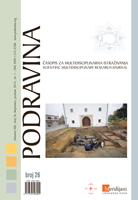- PRILAGODBE U ARHITEKTURI PODRAVSKIH UTVRĐENJA POJAVOM OSMANLIJSKE OPASNOSTI
- THE INFLUENCE OF THE NEW RURAL DEVELOPMENT PARADIGM ON CHANGES IN LAND USE: THE CASE OF POMURJE REGION
- KOMPARATIVNA FAUNISTIČKO-MIKROBIOLOŠKA ISTRAŽIVANJA BUNARSKE VODE VIRJA OD 1986. DO 1989. GODINE
- MODEL VOĐENJA CIKLOTURISTIČKIH RUTA NA PRIMJERU BJELOVARSKO-BILOGORSKE ŽUPANIJE
- LEPTOSPIROZA U KOPRIVNIČKO-KRIŽEVAČKOJ ŽUPANIJI
- ZAPISI ARTURA BENKA GRADE O NJEGOVOM SVRGNUĆU S MJESTA OKRUŽNOG UPRAVITELJA U BIHAĆU KRAJEM 1918. GODINE
- SREDNJOVJEKOVNI POSJEDI UZ GORNJE TOKOVE VELIKE I KOMARNICE
- IMENA I NADIMCI U ĐURĐEVCU OD SREDINE XVI. DO POČETKA XX. STOLJEĆA
- PHOTOVOLTAICS SYSTEMS ON THE TWO BANKS OF DRAVA RIVER
- VJERODOSTOJNOST MEDIJSKOG IZVJEŠTAVANJA O REFERENDUMU O BRAKU
- UPRAVLJANJE RAZVOJEM U KOPRIVNIČKO-KRIŽEVAČKOJ ŽUPANIJI U PROTEKLIH DVADESET GODINA I POGLED U BUDUĆNOST
- PRILOZI ZA POPIS ŽUPNIKA I UPRAVITELJA ŽUPA PODRAVINE OD SREDNJEGA VIJEKA DO 20. STOLJEĆA
- PRIKAZI NOVIH KNJIGA, ČASOPISA I ZNANSTVENIH SKUPOVA
LEPTOSPIROZA U KOPRIVNIČKO-KRIŽEVAČKOJ ŽUPANIJI
The study included three groups of patients with a confirmed diagnosis of leptospirosis treated at the Infectious Diseases ward of Dr. Tomislav Bardek General Hospital in the period from 1970 to 1975, from 2000 to 2005 and from 2010 to 31 October 2014 (for the final group, only data on incidence, age, gender and spatial distribution of residence were available). The purpose of this study was to examine whether there have been changes in the frequency, spatial distribution, presence of likely infectious serovars and clinical properties of the disease over the course of this long-time study. The first group consisted of 113 patients (mean age 21 years), the second of 39 patients (mean age 46.1 years) and the third group of 13 patients (mean age 50.1 years). The overall ages of patients ranged from 6 to 81 years. Males were predominant. The main characteristic of the first group was that it was comprised largely of school aged children (59/113, 52.2%), while the second and third groups were comprised of adult patients (mean age 48 years). In comparing the results, a significant and continuous drop in the incidence of the disease was observed: virtually three-fold drop between the first and second groups, and a greater than three-fold drop between the second and third groups. The average number of patients per year was 18.8 in the first group, 6.5 in the second group and 2.6 in the third group. The patients resided in 67 different settlements in the county. A total of 44 patients originated from a single settlement each, while 2–26 patients originated from the remaining 23 settlements. The most patients originated from the towns of Koprivnica and Đurđevac, and the settlements of Virje, Novigrad Podravski, Velika Mučna, Reka and Koprivnički Bregi. The highest frequency of patients resided in the territory of the town of Koprivnica (100, 60.6%). During the survey, the towns of Koprivnica and Đurđevac alternated in terms of frequency, i.e. as the incidence dropped in Đurđevac, it increased in Koprivnica. The clinical signs of the disease also changed significantly over time. The first group was characterised by patients with mild (76.1%) symptoms, while the second group was marked by moderate (30.7%) and serious (35.8%) symptoms of the disease. There were four times as many patients in the second group with serious clinical symptoms. The most frequency infectious serovar was icterohaemorrhagiae, which was most often present in those patients with serious clinical symptoms of the disease. During the survey, a significant increase in the presence of the serovars Australis, Poi and Hardjo was observed. This long-term study of leptospirosis clearly outlines the changes that have occurred over time in the frequency, spatial distribution, presence of infectious serovars and clinical symptoms of the disease. Despite the current knowledge, including this study, there are still many unknowns concerning this zoonosis.
Izvorni znanstveni rad / Original scientific paperdr. Ljiljana Mišić–Majerus

